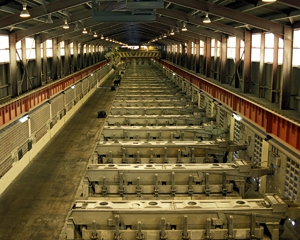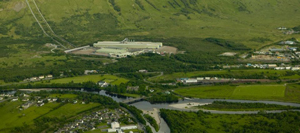One of the most comprehensive Kenwood NEXEDGE® digital radio systems has been completed by Brabourne Communications for Rio Tinto Alcan.
Nestled at the foot of Ben Nevis in the Scottish Highlands is the last remaining aluminium smelter in the United Kingdom.
The Rio Tinto Alcan [RTA] plant in Lochaber contributes over £8 million a year to the Highlands economy and employs 180 people, making it one of the region’s largest private sector employers.
The smelter converts alumina powder into aluminium ingots, an industrial process which is both hazardous and energy intensive. Key to the chemical reaction necessary to convert alumina to metallic aluminium is the running of an electrical current through a cryolite/alumina mixture.
An immense amount of power is required to produce aluminium which is why smelting plants are usually located in areas where affordable, sustainable electrical power is readily available.
Behind the Lochaber smelter is a 70MW hydroelectric power plant built in three phases between the early 1920’s and the mid 1940’s.
It harnesses a number of major rivers including the Mashie, Pattack, Spean and Spey.
Water from the Spey flows into Laggan and then on into Treig, some 30 miles away from the plant. From there, a 15 mile (24km), 15 feet (4.6m) diameter tunnel runs from Loch Treig and emerges on the side of Ben Nevis into a 240ft (73m) deep surge chamber some 600 ft (183m) above the smelter, which is connected via 5 large diameter steel pipes.

The hydroelectric power plant was subject to a £45 million investment between 2008 and 2012 to improve energy efficiency, increasing the usage of fully renewable energy and in turn, increasing production output. The power plant provides the energy needs of the smelting operation with clean, self-generated hydroelectricity while production output has increased from 43,000 to 48,000 tonnes per year.
The safe operation and maintenance of the hydroelectric plant and smelting operation creates unique challenges.
Fail-safe on-site radio communications forms an integral part of the backbone of RTA’s health and safety policy in and around the plant. Their ideal radio communications system would provide the flexibility they needed and also be easily configurable to support a range of applications.
RTA is also responsible for the maintenance of the civil engineering works between the power plant and smelter which includes regular inspections of the conduit at regularly spaced intakes.
Brabourne Communications Ltd [BCL] of Derby were tasked with proposing a system which would provide reliable on-site communications incorporating lone worker, man-down and other safety features. The system should also include telephone interconnect facilities to reduce the volume of costly and inefficient mobile phone usage on site.
The wide area solution needed to include the use of range extending portable repeaters, automatic vehicle tracking, SCADA and CCTV applications.
As the maintenance engineers are often working in very remote areas a reliable lone worker and man-down system was a high priority.
 Following an exhaustive analysis of available technologies, the Kenwood NEXEDGE® digital system was shown to be the most appropriate solution. It provided a seamless digital and analogue platform with its Analogue/Digital Mixed Mode (an important consideration as RTA operate both analogue and digital devices), and Kenwood were able to offer a range of applications which met RTA’s requirements cost effectively.
Following an exhaustive analysis of available technologies, the Kenwood NEXEDGE® digital system was shown to be the most appropriate solution. It provided a seamless digital and analogue platform with its Analogue/Digital Mixed Mode (an important consideration as RTA operate both analogue and digital devices), and Kenwood were able to offer a range of applications which met RTA’s requirements cost effectively.
For the smelter operation, a NEXEDGE® digital trunked network provides voice communications and allows RTA to reconfigure as required via the system manager as the network grows, including a second site installation at another hydroelectric power scheme at Kinlochleven.
The wide area network operates as a conventional analogue system and makes use of three high sites between Fort William and Spey.
This solution provides the bearer for the SCADA and CCTV images from the intakes while a microwave link completes the connection to the smelter from the Fort William high site.
 The employment of common terminal equipment for both analogue/digital and conventional/trunked operations makes the system simple to use and maintain. Another benefit of the system is that the seamless migration between different elements of the system makes training simpler and eliminates confusion for users.
The employment of common terminal equipment for both analogue/digital and conventional/trunked operations makes the system simple to use and maintain. Another benefit of the system is that the seamless migration between different elements of the system makes training simpler and eliminates confusion for users.
The system will also significantly reduce the costs of inspecting the pipeline intakes and enhance the safety of RTA employees.
The second phase of the project will see the installation of outstation equipment at each intake. This will comprise converted shipping containers which will house the power plant and associated equipment. Once installed, water levels and flow rates at each intake can be monitored remotely while CCTV will provide on-demand images of the intake to assess the need for maintenance. It is planned that this phase will incorporate the BCL Fire Alarm Warning System [FAWS] onto the trunked network to provide a fully networked fire alarm system with the additional benefit of displaying fire panel messages direct to portable radios, allowing staff too instantly and efficiently manage any events as they arise.